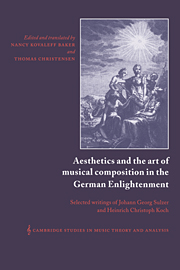 Aesthetics and the Art of Musical Composition in the German Enlightenment
Aesthetics and the Art of Musical Composition in the German Enlightenment Book contents
- Frontmatter
- Contents
- Foreword by Ian Bent
- PART I JOHANN GEORG SULZER GENERAL THEORY OF THE FINE ARTS (1771–74): SELECTED ARTICLES
- PART II HEINRICH CHRISTOPH KOCH INTRODUCTORY ESSAY ON COMPOSITION, VOL. II (1787)
- Introduction by Nancy Kovaleff Baker
- Preface
- Introduction
- I The aim and the inner nature of compositions and, above all, the way in which they arise
- Index
I - The aim and the inner nature of compositions and, above all, the way in which they arise
Published online by Cambridge University Press: 30 September 2009
- Frontmatter
- Contents
- Foreword by Ian Bent
- PART I JOHANN GEORG SULZER GENERAL THEORY OF THE FINE ARTS (1771–74): SELECTED ARTICLES
- PART II HEINRICH CHRISTOPH KOCH INTRODUCTORY ESSAY ON COMPOSITION, VOL. II (1787)
- Introduction by Nancy Kovaleff Baker
- Preface
- Introduction
- I The aim and the inner nature of compositions and, above all, the way in which they arise
- Index
Summary
[MUSIC AND FEELING]
Music is a fine art which has the intention of awakening noble feelings [sentiments, Empfindungen] in us.
Feelings lie dormant in man's nature and are properly aroused only by certain natural causes. For example, the possession of something which we suppose to be good engenders pleasure, and the idea that we might meet with misfortune awakens fear in us.
Feelings bring about resolutions: pleasure prompts us to seek certain possession of the good which produced it, and fear causes us {16} to take measures to prevent the dreaded misfortune from befalling us.
The fine arts in general, and thus also music, possess a unique property which enables them through artistic means [künstliche Veranlassungen] to awaken feelings in us. They awaken pleasure through the enjoyment of a good represented through art and fear through an evil brought forth by it. Thus, if the fine arts make use of their special power to have the feelings they arouse inspire noble resolutions, to affect the education and ennoblement of the heart, then they serve their highest purpose and show themselves in their proper worth. If deprived of this noble function, if used to another end, then the fine arts are degraded, they are dishonored.
Information
- Type
- Chapter
- Information
- Aesthetics and the Art of Musical Composition in the German EnlightenmentSelected Writings of Johann Georg Sulzer and Heinrich Christoph Koch, pp. 144 - 204Publisher: Cambridge University PressPrint publication year: 1996